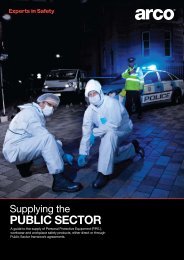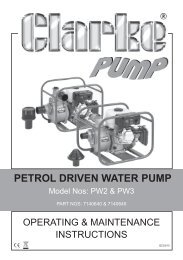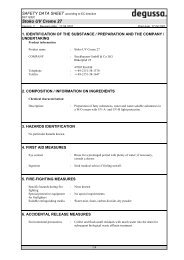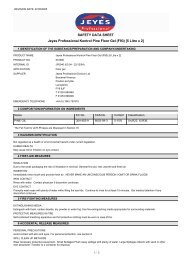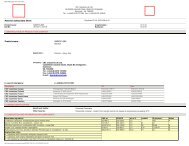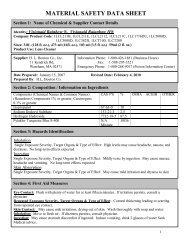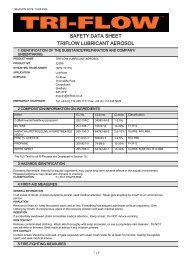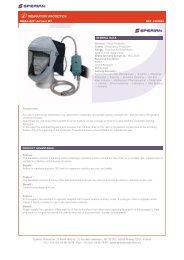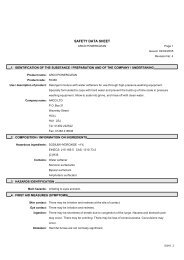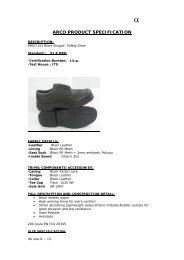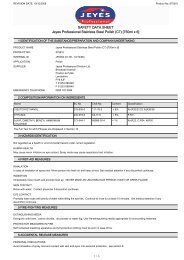Create successful ePaper yourself
Turn your PDF publications into a flip-book with our unique Google optimized e-Paper software.
contentsOUR SERVICE 2LEGISLATION 3-4CONFINED SPACE IDENTIFICATION 5-6Hazards to consider beforeentering CONFINED SPACES 7-8CONFINED SPACE ENTRY PROCEDURE 9CONFINED SPACE ENTRY TRAINING 10MOBILE CONFINEDSPACE ENTRY TRAINING 11-12BREATHING APPARATUSDECISION TREE 13GAS DETECTION 14-16SELECTION & USE OF PPE & RPE 17BREATHING APPARATUS 18SELF-CONTAINEDBREATHING APPARATUS 19AIRLINE BREATHING APPARATUS 20CONFINED SPACE RESCUE 21CONFINED SPACE RESCUE & ESCAPE 22VERTICAL ENTRY 23-26SAFETY LIGHTING 27-28SAFETY BARRIERS 29SIGNAGE 30<strong>Arco</strong> is the UK and Ireland’s leadingsupplier of personal protectiveequipment, workwear and workplacesafety products offering a world-classrange of over 170,000 products.As Experts in <strong>Safety</strong> we are widely recognised as a providerof specialist advice through our branch network and this isfurther supported by our training and consultancy division.We reach our customers through an extensive productcatalogue, interactive website, local Sales Offices and41 strong Trade Counter network. We pride ourselves onproviding customers with great availability, performanceand price.Founded in 1884 <strong>Arco</strong> has a heritage spanning fourgenerations. With traditional family values at the heart of thebusiness we pride ourselves on our core values; respect,hard work, enterprise and excellence in reputation. We fullysubscribe to the ETI’s Nine Principles Base code and havefully incorporated the internationally recognised code oflabour practice into our own ethical policy. In 2007 <strong>Arco</strong> wasthe first distributor in our industry to become a member ofthe Ethical Trading Initiative (ETI) and in 2010 we became amember of Sedex, the Supplier Ethical Data Exchange. Wecontinually support local communities and charities donatingin excess of 1% of pre tax profits annually.As we are members of the BSIF Registered <strong>Safety</strong>Suppliers Scheme you can be confident that we will supplysafety equipment which is genuine and compliant with therelevant standards and regulations. The BSIF monitor andregulate members of the scheme by conducting regularstandards audits.Our ServiceAs part of our commitment to keeping people safe in the workplace, we havecreated this expert guide to highlight the existence of confined spaces, the hazardsthat may be encountered in confined space work and other factors to be consideredbefore anyone enters such an area.This is a brief guide and anyone contemplating managing confined space work,carrying out a risk assessment, preparing a safe system of work or entering aconfined space must ensure they have the competencies required at all levels orseek assistance from someone who does before any entry is made.This Expert Guide is designed to provideguidance on the following:• Current legislation around working in confined spaces• Hazard identification• Safe systems of work• Competence• Training• Rescue• Product suitabilityOur aim at <strong>Arco</strong> is to help you to conform with The Healthand <strong>Safety</strong> at Work etc Act 1974, which states that it is theemployer’s duty to ensure their employees are safe fromharm while at work, as far as reasonable, practicable, safeand without risks to health.Legislation:The <strong>Confined</strong> Space Regulations 1997 defines a confinedspace as a place which is substantially (though not alwaysentirely) enclosed and there is a reasonably foreseeable riskof serious injury from hazardous substances or conditionswithin the space or nearby.Under The Management of Health and <strong>Safety</strong> at WorkRegulations 1999 a risk assessment must be completedto identify the risks of the work activity and the measuresthat need to be implemented to ensure a safe workingenvironment and try to eliminate entry in to the confinedspace by reviewing a different approach.The Personal Protective Equipment at Work Regulations2002 and the Control of Substances Hazardous to Healthstate: The risk to health and safety should be assessedon how to prevent or reduce the workers exposure tohazardous conditions and substances. The PersonalProtective Equipment at Work Regulations 2002 andthe Respiratory Protective Equipment Guidance HSG53stipulate that PPE and RPE is to be supplied and usedat work wherever there are risks to health and safetythat cannot be adequately controlled in other ways. It isessential that anyone using PPE and RPE, understand whythey require the equipment, when and how it should beused, repaired or replaced and if there are any limitations.The employer is duty bound to provide training on all PPEand RPE equipment.All of <strong>Arco</strong>’s PPE and RPE conform to all relevant Europeanstandards and carries the CE mark, complying withthe requirements of the Personal Protective EquipmentRegulations 2002 and the Respiratory ProtectiveEquipment at Work Guidance HSG53. The CE markingsignifies that the protection satisfies the necessaryrequirements and in some cases will have been tested byan independent body.We have brought to you a range of training, services andproducts suitable for keeping you safe while working inconfined spaces.1www.arco.co.uk/confinedspaces2© <strong>Arco</strong> Limited. All rights reserved. Terms and conditions apply, available on request or from www.arco.co.uk
LegislationIreland LegislationIn the UK the <strong>Confined</strong> Space Regulations 1997 specifically pertain to theidentification and management of confined space working, the regulations arepublished with an accompanying Guidance and Approved Code of Practice (HSEL101). The regulations apply to all premises covered by the Healthand <strong>Safety</strong> at Work etc Act 1974 with the exception of mines and diving operations.The regulations and the Approved Code of Practice mustbe considered before any attempt to enter a confinedspace. One of the key requirements of the regulations isfor employers to find a reasonably practicable method ofcompleting the work in the confined space without entry.The requirements of the Health and <strong>Safety</strong> at Work etc Act1974 and the Management of Health and <strong>Safety</strong> at WorkRegulations 1999 would also have to be considered in thepreparation of any risk assessment and safe system ofwork including training.Other legislation may also be relevant depending onthe work to be carried out in the confined space, wherehazards such as hazardous substances, manual handling,electricity and work at height may be present.Personal protective clothing and equipment along withrespiratory protective equipment may be specified andused in confined spaces and this will mean the relevantregulations surrounding the supply, maintenance andtraining will also have to be considered.Source: The <strong>Confined</strong> Space Regulations 1997Health and <strong>Safety</strong> Executive: <strong>Confined</strong> <strong>Spaces</strong>,A Brief Guide to Working SafelyOther regulations that need to betaken in to consideration whenworking in confined spaces are:• The Health and <strong>Safety</strong> at Work etc Act 1974• The Management of Health and <strong>Safety</strong>at Work Regulations 1999• The Personal Protective Equipmentat Work Regulations 2002• Respiratory Protective Equipment at WorkGuidance HSG53• The Control of Substances Hazardous to HealthRegulations 2002• The Provision and Use of Work EquipmentRegulations 1998• Electricity at Work Regulations 1989• Workplace (Health, <strong>Safety</strong> and Welfare) Regulations 1992• Control of Noise at Work Regulations 2005• Control of Lead at Work Regulations 2002• Control of Asbestos Regulations 2012• Work at Height Regulations 2005The <strong>Safety</strong>, Health and Welfare at Work(<strong>Confined</strong> <strong>Spaces</strong>) Regulations 2001 coverall work in relation to confined spaces.It is the duty of every employer or self-employed person tocomply and implement the provisions of these regulationsin respect to any work being carried out in a confinedspace. The regulations do not apply to any place belowground in a mine (as defined by the Mines and Quarries Act1965) or to any diving operations.The regulations state:• <strong>Confined</strong> space entry is prohibited, providing the workcan be carried out in a reasonably practicable way andby other means• A risk identification and evaluation must be carried outbefore entering a confined space detailing the purpose ofthe work involved• A safe system of work must be completed before entry into the confined space• The person conducting the safe system of work needs tobe experienced, trained and suitably informed about thework involved• It is imperative that a rescue plan is in place, detailing thearrangements in case of an emergency• The emergency arrangements will need to demonstratehow to raise the alarm, the type of rescue equipment,resuscitation equipment and rescue teams, the provisionof correct information, instruction and training is requiredon all these elements identified• Implementation of the rescue planSource: http://www.hsa.ie/eng/Topics/<strong>Confined</strong>_<strong>Spaces</strong>/http://www.irishstatutebook.ie/2001/en/si/0218.html3 www.arco.co.uk/confinedspaces4
<strong>Confined</strong> SpaceIdentification<strong>Confined</strong> spaces are found in many industries across the world. The existence ofconfined spaces in some workplace environments is reasonably easy to identify andunderstand. Tanks, vessels, sewers and the like are known to be confined spaces topeople in the industry that use them and arrange work inside them.Every year people arekilled or seriously injuredin the UK across a rangeof industries while workingin confined spaces. Highrisk industries include oiland gas, petro-chemical,utilities, shipping andmarine, manufacturingand tank cleaning.The existence of confined spaces inpredominantly commercial, or non-industrialpremises, is less well known. Service ducts,loft and void spaces, some plant roomsand similar areas are found in premiseslike hospitals, universities and other largepremises.The regulations identify confined spaces primarily assomewhere that is substantially, but not always entirely,enclosed. This description illustrates that, for example, anopen topped pit may have easy access but the possibilityof the presence of heavier than air gases would make it aconfined space. Similarly an open topped or open endedcarbon steel tank or container that features rust insidecould also be a confined space due to the lack of oxygen.The secondary, though equally important, considerationwhen identifying confined spaces is the reasonablyforeseeable risk from hazards in the confined spaceor nearby.Some confined spaces will develop during construction;for example the assembly of a tank or process plant,particularly where welding takes place on the inside.Proposed Entry into a <strong>Confined</strong> SpaceWhere a confined space has been identified and theneed to carry out some form of work inside the space isneeded then the following should be considered:-Preventing the need for entry, where work in a confinedspace is required then employers, and the self-employed,have to consider reasonably practicable methods of doingthe work from the outside, thus preventing entry. Thismight be remote sampling, inspection or cleaning forexample. This is a requirement for every proposed confinedspace entry job and subsequent risk assessments shouldidentify and define that this ‘prevention of entry’ processhas taken place.Where the work cannot be achieved by a reasonablypracticable remote or outside system then a safe system ofwork will have to be developed.Developing a safe system of work – the safe system ofwork will begin by a competent and experienced personcompleting a risk assessment. The factors to considerwhen producing a risk assessment are those listed in theforegoing hazard detail section of this guide, as a minimum.Other factors detailed in the approvedcode of practice and to be dealt with inturn where applicable are:-• Supervision• Competence• Testing and monitoring the atmosphere• Gas purging• Ventilation• Removal of residues• Isolation from gases, liquids, other flowingmaterials• Isolation from electrical and mechanicalequipment and stored energy• Selection of suitable equipment• Personal protective equipment and respiratoryprotective equipment (PPE and RPE)• Gas cylinders and internal combustion engines• Gas supplied by pipes and hoses• Safe way in and out• Fire prevention• Lighting• Static electricity• Smoking• Emergencies and rescue• Limiting working timeEach hazard should be addressed in turn andreasonably practicable control measures developedand applied in each case.Ensure personnel at all levels are competent andsuitably trained.5 www.arco.co.uk/confinedspaces6
Hazards to consider beforeentering confined spacesThe main hazards to be considered beforeentering confined spaces are as follows:-Reduced physical dimensions - Which can inthemselves, be hazardous simply because they canmake the way in and out of a confined space difficult tonegotiate and similarly make movement inside restrictiveand increase exertion levels. There is also the possibility ofgases being trapped in low lying areas inside the confinedspace for example where ventilation may be difficultto achieve or maintain. Consideration should alwaysbe given to the possibility of an incapacitated personhaving to be rescued from inside the confined space. Theuse of breathing apparatus and rescue stretchers andequipment becomes much more difficult in areas of smallerdimensions and specifying the right equipment and havingit to hand before the first entry is very important.Lack of oxygen – The normal oxygen level is 20.9%.19.5% is the minimum working level, below which harmcan occur to anyone in the confined space. A lack ofoxygen will affect the functioning of the brain quite quicklyand reduce the affected person’s ability to respond to theirenvironment. Oxygen can be diminished by the presence ofrust or the contents of the confined space or by operationssuch as welding or burning. Materials such as wet grain canalso deplete oxygen. At levels below 16% unconsciousnessand death can occur.Excess of oxygen – The normal oxygen level is 20.9%,the maximum is 23.5%, levels above this figure canincrease the risk of fire, particularly in clothing. Excessoxygen is usually caused by leaking oxy/fuel gas cuttingand welding equipment.Flammable substances – May be present in the confinedspace, and could cause fire or explosion if ignited. Thesecan be from gases, fumes, vapours and dusts and maycome from the confined space contents or from thematerials being used to clean the confined space, forexample a flammable liquid base or propellant gases ofaerosol sprays. In addition to the possibility of the presenceof the above materials, detritus and discarded materialsfrom repair operations in confined spaces can also beignited by hot work operations. Where there is a possibilityof flammable substances being present in a confined spacethen suitable equipment, including electrical equipment,will have to be specified to eliminate the risk of a sparkor ignition source. Static electricity can also be a sourceof ignition in confined space operations where flammablegases and vapours are present as can incorrectly specifiedelectrical equipment.The possible presence of toxic gases fumes andvapours – Which can be identified using correctly specifiedatmospheric testing equipment. Consideration shouldbe given to the possibility of gases trapped in residuesand sludge, scale or animal waste which may not havebeen identified by initial atmospheric testing and may bedisturbed and released by someone in the confined space.Toxic gases, fumes and vapours may contaminate theconfined space from outside; from nearby processesor vehicle exhaust fumes for example. Where work inexcavations is taking place then the contamination cancome from hazardous substances previously depositedin the ground or from natural sources such as limestoneproducing carbon dioxide.The unintended ingress of materials – Can occur whenconnected pipes, ducts and conveyors etc. are not isolatedand disconnected from the confined space. Considerationshould be given to the delivery or supply system for thenormal contents of the confined space, the back-flow fromany exit methods from the area such as pipes and sumps.Liquids unintentionally entering the confined space maycause drowning or the liquid may have corrosive or toxicproperties. Powders and granulated materials, such assugar, grain and sand can submerge someone in a confinedspace and prevent them from breathing.Excessive heat – Can also create problems for peopleworking in confined spaces. Excessive heat can causeheat stress, leading to heat stroke and unconsciousnessand possibly death. The heat can come from a plant, suchas boilers or oven that has not had sufficient cooling timebefore entry or from the use of steam cleaners or hot waterhigh pressure jetting systems. The effect of the sun’s rayson steel tanks and vessels can also cause the internaltemperature to rise.Inadequate ventilation or the lack of chilled ventilation alongwith the confined space entrants wearing chemical protectionsuits, which impair natural body temperature control, canexacerbate the heat problems in confined spaces.Other hazards - There are a number of other hazards,already referred to in the Legislation section, that can createproblems for anyone entering a confined space. Typicallythese could include hazardous substances, includingbiological, other than those causing the specified problemsabove, mechanical and electrical hazards or a combinationof both, noise and vibration, lack of light and so on. Whilstthese hazards are not specified in the confined spacesregulations they will still have to be considered, once the riskis assessed and where the risk cannot be prevented, suitablecontrol measures must be provided and take into accounteach hazard’s own regulation or approved code of practiceand guidance if applicable.Manufacturing or constructing new plants,buildings or infrastructureWhere a new plant is being manufactured which will be afixed structure or where new construction is taking placethen the requirements of the Construction, (Design andManagement) Regulations 2007 will have to be taken intoaccount. These regulations require the safe construction,maintenance, cleaning and demolition of structures andbuildings so, by default, the minimisation of the presence ofconfined spaces will be a requirement.7 www.arco.co.uk/confinedspaces8
<strong>Confined</strong> SpaceEntry ProcedureIs it a confined space?Identify foreseeable specified risks<strong>Confined</strong> SpaceEntry Competenceand TrainingPersonnel involved in confined space work whether those entering or thosein support or preparing safe systems of work should be experienced andcompetent, both in confined space entry and the task to be undertaken. If not itis essential that they undergo a full practical training programme.Yes<strong>Confined</strong> Space Regulations applyDoes the space meet the specified risks highlighted inthe regulations governing the entry to confined spaces?Can the work be carried out in another way to avoid entry or work inthe confined space that is reasonable practicableNo• Risk assess all aspects of the work relating to the confined space• Risk assess all identified hazards inside and outside the confined space<strong>Confined</strong> Space Regulations do not applyYesNoSafe system of workto be developeddemonstrating thealternative workmethodThe requirements for all confined space training are detailedin The <strong>Confined</strong> Space Regulations 1997.The training should equip personnel withcompetency and understanding of:• The need for preventing entry into confined spaces,as far as is reasonably practicable• The hazards and the control measures andprecautions• Safe systems of work and, if appropriate, the use ofpermits to work• How emergencies arise, emergency procedures, howto follow them and the dangers of not doing soTraining will also include a practical element to realisticallysimulate confined space conditions and working. Thisshould be practised thoroughly to ensure competence.This practical training will also confirm a person’s suitabilityfor work in confined spaces; whether they are physicallyfit and able to enter the space, for example if they sufferfrom claustrophobia.Refresher training will be required periodically and itstiming will depend on the continued experience afterinitial training. For example, those completing training andworking on a small number of jobs immediately afterwardsare likely to have forgotten much of the training if a periodof months passes before the next confined space entry job.Additionally, personnel will need training on the use of itemsof equipment involved in safe confined space entry; suchas gas monitors, self-rescue breathing apparatus, possiblyself-contained breathing apparatus, and personal protectiveequipment along with any equipment used.Develop a safe systems of work with the following considerations:• Risk Assessment• Method statement• Permit to work• Competence at all levels• Training• Atmospheric testing• Ventilation• Monitoring• Inspection• Personal protective equipmentand respiratory protectiveequipmentDevelop a rescue plan and ensure those involved at all levels aresuitable trained on the rescue procedure, communication systemand the equipment involvedCarry out work in the confined space<strong>Arco</strong> Training &Consultancy Courses:<strong>Arco</strong> Training andConsultancy can providetraining on Dynamic RiskAssessments, Safe Systemsof Work, Permit to Work and<strong>Confined</strong> Space Entry TrainingSource: The <strong>Confined</strong> Space Regulations 19979 www.arco.co.uk/confinedspaces10
Mobile <strong>Confined</strong> SpaceEntry Training<strong>Arco</strong> Training & Consultancy offer expert training and specialist safety servicesfor working in confined spaces. We take time to understand your needs anddevelop courses, training and services to mirror the way you work, enablingmaximum benefit to you and your employees.The confined space entry mobile training unit enables confined space training,face fit testing and breathing apparatus training with both theoretical andpractical training to take place on site.For more information contact:UK: Tel: +44 (0)1482 347590 or email: services@arco.co.ukIreland: Tel: 01409 5000 or email: services@arcosafety.ieAccredited, non-accredited andbespoke trainingDesigned to accommodate a variety of industry confinedspace standards, this new unit incorporates advancedtechnology and can be used for accredited trainingincluding all levels of City and Guilds approved courses,non-accredited and bespoke training. The coursesdelivered from the unit are designed around real lifeconfined space incident scenarios.Practical training covers actual entry, suitability checks(i.e. for claustrophobia), selection and use of equipment,developing a safe working system, and the initiation ofself-rescue or full rescue.Advanced TrainingOur team also has experience in delivering more in-depthrescue courses covering trauma assessment and realisticrescue scenarios.Refresher TrainingThere is not a specified time in which confined spacetraining has to be renewed, however employers shouldalways ensure that their employees are not only trainedin the relevant skills, but remain competent in them aftera period of time. It is recommended that <strong>Confined</strong> SpaceEntry Refresher Training is provided at least three yearsafter the initial training.Face fit testing and breathing apparatustrainingThe unit is fully equipped to deliver onsite face fit testingand breathing apparatus training on sites such as oilrefineries, petrochemical plants and power stations.The mobile confined space unit provides:• Cost saving and minimal disruption• Rapid set up of the totally self-sufficient unit• Live monitoring and videoing of training• Realistic simulation of industrial environments• Vertical entry, with over 3 metres vertical access• Horizontal entry, 30 metres of internal tunnels• Training equipment supplied<strong>Arco</strong> Training & Consultancy alsoprovide training on:• Risk Assessments• Health and <strong>Safety</strong> Legislation• Managing <strong>Safety</strong>• Hazardous Substances• Safe Systems of Work• Fire and Explosion• Risk Control• Policy Writing• Harness Inspection11 www.arco.co.uk/confinedspaces12
Breathing ApparatusDecision TreeThe diagram below gives simple guidance on choosing the most appropriate breathingapparatus for working in a confined space. It highlights the key factors which mustbe considered when choosing the correct equipment to ensure that it best meets therequirements of the user to allow them to work safely and comfortably.These factors include assessing the risk of oxygen deficiency and the potential for a contaminated atmosphere whichcould present an atmosphere which is immediately dangerous to life or health as well as considering the duration of thejob, working conditions and time it would take to escape if there was a hazard.<strong>Confined</strong> <strong>Spaces</strong>Respiratory Decision TreeDo you know the potentialgas hazard?YesCan you monitor for thepotential gas hazard?YesNoNoNoHas it been determinedthrough a risk assessmentthat a breathing apparatusis required?YesIs the atmosphere oxygen deficientor are there toxic gases presentwhich make it immediately dangerousto life & health?YesWhat is the durationof the job?1hrCarry out a RiskAssessmentDo you require escapefacility?Gas DetectionGas detectors monitor the levels of flammable gases, oxygen enrichment ordepletion and toxic gases, providing personal protection from a wide range ofindustrial hazards when entering a confined space.Scott <strong>Safety</strong> gas detectors are easy to use with single button operation andincredibly reliable, giving industrial workers and first responders the confidenceto focus on the task at hand.The Protégé ZM provides a zero maintenance alternative which measuresoxygen, carbon dioxide or hydrogen sulphide. The Protégé ZM delivers two years of gas detection without charging,calibration or maintenance, providing high performance with low ownership costs. The devices are designed to belightweight, so they can be attached easily to the user where most comfortable, but also robust in order to withstand therigour of a range of different industries.The Protégé multi-gas monitor is designed to monitor potentially hazardous levels of combustible gases, oxygenenrichment or depletion, carbon monoxide and hydrogen sulphide. It has been designed to be a simple and easy to useunit with enhanced user ergonomics.Scott Protégé ZM Zero MaintenanceSingle Gas Monitor• Use hibernate mode on the CO and H2S models for up to one yearadditional operating life• Custom or factory programmed alarm set points• User configurable bump and calibration reminders• Multiple LCD display options including real-time gas readings,monitor life remaining or both• Three point alarms (audible, visual and tactile)• Data-logging capabilities• Name or assign monitors using a six-character user IDATEX Directive approved (94/9/EC)ATEX II 1 G Ex ia IIC T4Ref:Ref:Ref:4T0816 – O24T0814 – CO4T0815 – H2SHow long will it take youto follow your escape route?Is the working space orentry point very tight?YesYesNoScott Protégé Multi-GasThe Protégé multi-gas monitor is simple to use and incredibly durable,giving industrial workers and first responders the confidence to focuson the task at hand.15minNoSCBA SetWorkers can use anindependent air source to workin an irrespirable atmosphere.Working duration is limited bycylinder size and access intotight spaces can be difficultAirline Escape SetAirline SetEscape options increase safety should there be anissue with the external air source.• An intuitive user interface and simple two button operation makecalibration and basic operation virtually thought free• Protégé software, compatible with Windows, gives administrators theability to quickly adjust monitor configurations• Its robust construction survives drops while being dust tight andimmersion resistantATEX Directive approved (94/9/EC)ATEX II 1 G Ex ia IIC T4Ref:Ref:Ref:4T0810 - Gas Monitor Kit PRO1Z-2212 O2 LEL H2S CO4T0811 - Gas Monitor Kit PRO1Z-1212 O2 LEL H2S CO4T0813 - <strong>Confined</strong> Space PRO1Z-1111 O2 LEL H2S CO13 www.arco.co.uk/confinedspaces14
Gas DetectionThe MSA ALTAIR range of portable gas detectors provides solutions to mostindustrial applications. Built to the highest quality standards the ALTAIR range isrecognised for its simple-to-use features and its rugged reliable designMSA ALTAIR 5X Multi-Gas DetectorThis high-performance multi-gas detector featuring MSA’sXCell sensors provides outstanding durability and reliability.Unique features such as MotionAlert and InstantAlertprovide added confidence when working in confined spaceentry situations.• Ergonomic design with large glove-friendly buttons andlarge easy-to-read display• MotionAlert option tells others that user has becomeimmobile• InstantAlert provides manual alarm to alert others of adangerous situation• Versatile MSA Link allows user to transmit data to acomputer• Only weighs 454g• Comprehensive data logging facility• “End of sensor life” warning• Rapid bump test gives results in under 15 seconds• Up to 18hr run time, charging time up to 6hrs• Passes 10ft drop test• Wireless USB option• Optional glow-in-the-dark version• 3-year warranty• Other sensor configurations are availableATEX-approved II 2G Ex d ia mb IIC T3/T4 G6 - Zone 1Delivery 7 DaysRef: 4T4000 – O2, CO, H2SRef: 4T4100 – O2, CO, H2S, CI2Ref: 4T4400 – O2, CO, H2S, CO2 (0-5%)Ref: 4T4500 – O2, CO, H2S, SO2MSA ALTAIR Maintenance-Free Single-GasDetectorThe MSA ALTAIR is a reliable high-performance single-gasdetector that is simple to use and extremely economical.• Two years or 1080 alarm minutes of service life underwarranty with no maintenance• Simple, easy-to-read display• Single button press to carry out bump check test• Designed to withstand a 3m drop test• Triple alarm system effectively alerts the wearer to anydanger• Records the last 25 alarm events automatically, offeringthe ability to assess recent alarm conditions• Three sensor options: H2S, CO and O2• Ingress protection rating is IP67ATEX-approved II 2G EEx ia IIC T4 –20°C to +50°CRef: 4T0700 – O2Ref: 4T0800 – CORef: 4T0900 – H2SMSA ALTAIR 4X Multi-Gas DetectorThe ALTAIR 4X is a tough, functional and reliablemulti-gas detector for LEL, CO, H2S and O2.The rugged housing provides unsurpasseddurability, including the ability to withstand a 6mdrop onto concrete. The large glove-friendlybuttons and high-contrast display make theALTAIR 4X easy to use in any work environment.• MSA XCell sensors design gives a typical life of morethan 4 years• IPC67 rated and passes 6m drop test• Rechargeable li-polymer battery with charge time lessthan 4hrs• Size 112x76x35mm, weight 222g• Std 50hr minimum data log• 24hr run time• Three-year standard warrantyATEX-approved II 1G Ex ia iiCT4, -40°C to +60°C, IP67Delivery 7 DaysRef: 4T1300 – DetectorRef: 4T1500 – Detector with Luminous CaseRef: 4T1400 – Detector with 4-Year WarrantyMSA ALTAIR 4X Bump Check KitThe Altair 4X Bump Check Kit provides everything neededto undertake a quick and easy bump test. Simply apply thecap, press the button and turn on the gas.• Test in under 15 seconds• 24 hour check mark displayed on Altair 4X once it passesthe test• Date, time and result of tests are recorded in the detectorRef: 4T4900ARCO TRAINING& CONSULTANCYCALIBRATION SERVICE:• Six month requirement• <strong>Arco</strong> Training & Conultancyoffers a gas detectorcalibration service for theMSA range• Speedy on-site service orcalibrationTO FIND OUT MORE CALL+44 (0)1482 34759015 www.arco.co.uk/confinedspaces16
Selection and Use ofPPE & RPEBreathingApparatusThe Health and <strong>Safety</strong> at Work etc Act1974 and the Management of Healthand <strong>Safety</strong> at Work Regulations 1999require you to provide and maintain asafe working environment, so far as isreasonably practicable.In addition, the COSHH Regulations 2002 stipulate,Respiratory Protective Equipment may need to be used tosatisfy requirements when working in confined spaces.The Personal Protective Equipment at Work Regulations2002 (PPE) and the Respiratory Protective Equipment atWork Guidance HSG53 (RPE) state that PPE and RPEshould only be used where there are risks to health andsafety that cannot be controlled in other ways.When supplying PPE or RPE, it is the duty of the employerto provide training on the equipment, ensure the equipmentis maintained in good order and ensure the maintenancerecords are documented.It is imperative that anyone using PPE or RPE understandwhy they need the equipment, when and how it should beused, repaired or replaced and if there are any limitations.To select the right PPE and RPE you will have to takeaccount of the properties of the hazardous substances, theneeds of the wearer, the work and workplace conditions.MSA’s range of self-contained breathing apparatus systems are designed for longlife and low maintenance. With a variety of pre-configured sets designed to meeta wide range of industrial applications and a bespoke service allowing you tocustom build a set to meet your own needs.MSA AirGo Pro Self-Contained BreathingApparatusSpecifically designed for emergency response and escapepurposes in industrial applications AirGo compact is theobvious choice in areas where SCBA sets are mandatory.• High-quality construction• Integrated warning whistle• Padded straps for wearer comfort• Ergonomic back plate for comfort and balance• Long cylinder strap, suitable for single ortwin cylinder use• Low maintenance costs• Face mask and cylinder purchased separatelyApproved to EN 137:2006, type 2Atex II 1 G c IIC T6Delivery 14 DaysRef: 21M4100All of <strong>Arco</strong>’s PPE and RPE conforms to all relevantEuropean standards and carries the CE mark, ensuringthe equipment complies with the requirements of thePersonal Protective Equipment Regulations 2002 andthe Respiratory Protective Equipment at Work GuidanceHSG53. The CE marking signifies that the protectionsatisfies the necessary requirements and in some cases willhave been tested by an independent body.Face Fit Testing and BreathingApparatus Training<strong>Arco</strong> Training and Consultancyhas the largest RPE team in theUK, providing face fit testing,breathing apparatus trainingand RPE Management.TO FIND OUT MORE CALL01482 347590Source: Health and <strong>Safety</strong> Executive: RespiratoryProtective Equipment at Work, A Practical Guide. HSG53(Fourth edition, published 2013).Health and <strong>Safety</strong> Executive: Personal ProtectiveEquipment (PPE) at Work, A Brief Guide.MSA Ultra Elite-PS-MaXX Full Face MaskCombining practical experience and modern design toprovide superior performance, comfort and durability in afull face mask.•Ergonomic design and five-point adjustment harnessfor comfort• Large visor allows excellent field of vision• Silicone material• For use with AirGo Pro and AirGo Compact SCBA andAutoMaXX demand valveApproved to EN 136 Class 3Delivery 14 DaysRef: 21M4300MSA AutomaXX Demand ValveDesigned for use with the AirGo Pro this positive-pressuredemand valve delivers a sensitive response to theindividual’s breathing in the toughest conditions.• Swivel action on the face piece allows maximum freedomof movement• Activated by first breath• Automatically shuts down positive pressure whenremoved from mask• Low maintenance• MaXX plug connectorApproved to EN 137:2006Ref: 21M4200MSA Breathing Air CylindersMSA breathing air cylinders for use with MSA SCBA sets.6 litre / 300 barRef: 21M4400 – CompositeRef: 21M4500 - Steel17 www.arco.co.uk/confinedspaces18
Self-ContainedBreathing ApparatusAirlineBreathing ApparatusScott <strong>Safety</strong>’s range of SCBA units deliver breathable air from a cylinder carriedby the wearer in environments which are immediately dangerous to life or health,such as oxygen deficient atmospheres.An SCBA allows the user freedom of movement by allowing them to operate independently from a remote air source suchas a compressor.Ideal for environments where the ambient oxygen cannot be guaranteed, airlinebreathing apparatus combine the highest degree of respiratory protection withlong duration use. Air is supplied to the user from a remote air source througha compressed air supply hose. The complete modular system allows users toconfigure a unit which exactly meets their operational requirements.ASSFX & ACSf SCBA Contained Breathing ApparatusThe ACS represents a major advancement in SCBA. Significantly lighterthan any other carrying system and offers the wearer the ultimate in comfortand flexibility, comprising a light weight flexible back plate with Kevlar blendcylinder band and fully adjustable padded body harness with swivel movementwaist belt. Fully adjustable waist belt can be simply moved to 3 positions toprovide 3 sizes of back plate to cater for different sized users.• Reduced user burden – The lightest carrying system in its class• Lower through life costs/Easy upgrade path• Easy decontamination – Both back plate and harness can be washed• High performance pneumatics, exceptionally high airflowApproved to EN137:2006 Type II and MED*Apparatus supplied less facemask, please order desired mask separatelyRef: 21A9100Scott Vision 3 Face MaskPositive-pressure face mask with silicone outer and TPE inner mask.• Uniquely shaped visor for improved vision• Left-sided quick-fit connection for demand valve• Adjustable rubber head harnessApproved to: EN136Ref: 2115600Scott Sigma-2-PS SetLow-cost self-contained breathing apparatus set supplied completewith a black neoprene panaseal face mask.• Moulded composite backplate• Fully adjustable, flame-retardant polyester harness• Ideal for marine applications• Cylinder supplied separatelyApproved to EN 137Assigned protection factor 2000Ref: 2107500Scott Air Filter UnitTwo-stage filtration unit for use with Scott AirlineBreathing Apparatus.• Effective filtration of particles and oil• Charcoal element removes nuisance odours• Clogged pre-filter warning• Oil and water auto drainAFU 300 with single outlet, provides 300 litres of air per minuteAFU 600 with twin outlet, provides 600 litres of air per minuteRef: 183700 – AFU 300Ref: 183800 – AFU 600Scott Flite Airline Breathing ApparatusCan be used either as a working set for general industry oras an airline escape set.• Compact automatic positive-pressure demand valve• Side-mounted• Constant flow by-pass• Lightweight harnessFace mask and cylinder purchased separatelyApproved to EN 139 and EN402Ref: 21A1000 – Flite AirlineRef: 2103100 – 10 Minute CylinderContact your local branch for the full range of Airline Breathing Apparatus19 www.arco.co.uk/confinedspaces20
<strong>Confined</strong> SpaceRescue<strong>Confined</strong> SpaceRescue & EscapeIt is a requirement that suitable and sufficient arrangements for rescuing anincapacitated person from a confined space is implemented before the workbegins. This will include having sufficient equipment and trained personnel tocarry out a rescue. Consideration should be given to all foreseeable injuries orsituations not just the specific hazards detailed in the approved code of practice.On longer or more complex jobs it is good practice to contact the emergency services if they are to be called upon toassist with a rescue but it should be noted that the emergency services cannot be the only form of rescue provision; i.e.‘call 999’ is not a suitable and sufficient rescue plan.In the <strong>Confined</strong> Space Regulations 1997 training must be provided on:• The likely causes of an emergency• The use of rescue equipment, e.g. breathingapparatus, lifelines, and where necessary aknowledge of its construction and working• The check procedures to be followed when donningand using apparatus• Checking of correct functioning and/or testing ofemergency equipment (for immediate use and toenable specific periodic maintenance checks• Identifying defects and dealing with malfunctions andfailures of equipment during use; works, site or otherlocal emergency procedures including the initiation ofan emergency response• Instruction on how to shut down relevant processplant as appropriate (this knowledge would berequired by anyone likely to perform a rescue)• Resuscitation procedures and, where appropriate,the correct use of relevant ancillary equipmentand any resuscitation equipment provided(if intended to be operated by those receivingemergency rescue training)• Emergency first aid and the use of the first aidequipment provided• Use of fire-fighting equipment• Liaison with local emergency services in the eventof an incident, providing relevant information aboutconditions and risks, and providing appropriate spaceand facilities to enable the emergency services tocarry out their tasks• Rescue techniques including regular and periodicrehearsals/exercises. This could include the use of afull-weight dummy• Training should be realistic and not just drill based,and should relate to practice and familiarity withequipment.Source: The <strong>Confined</strong> Space Regulations 1997Additionally training will be required on all the equipment that will be used to successfully complete the rescue operationand it is essential that all rescue training is practised until a competent response can be achieved in an emergency.This equipment could include any or all of the following:-• Means of sounding the alarm• Means of communicating with emergency services• Breathing apparatus (separate air supply)• Personal protective equipment for the rescuers• Winch for lifting the casualty• Harness and lanyard• Stretcher for removing the casualty horizontally• Torches• First Aid equipment – resuscitator• Fire-fighting equipment• Tripod/winch• LifelinesEscape sets are only meant to be worn in situations where the breathable air qualityhas been compromised and it is critical to quickly escape contaminated areas.The ELSA range must only be used as a means of escaping and should not beused for normal working, entry hazardous areas or rescue.Scott Cen-PaqSimple, quick-to-don short-duration BA set built in to a highlyvisible jacket.• Ideal for survey work, sewer work, rescue situations• Proven pneumatic system• Pressure gauge and warning whistle• Facemask stowage pouch• Lightweight – less than 7.5kg including cylinder and maskFace mask and cylinder purchased separatelyApproved to EN 137Assigned protection factor of 2000Ref: 2106400 – Jacket & Pneumatics OnlyRef: 2106200 – 20 Minute CylinderScott Elsa Sprint 10 Minute Escape SetLightweight positive-pressure escape set with panasealface mask for escape purposes.• Ideal for smoke, gas or chemical escape applications• Provides 400 litres of breathing air• Automatic start up and positive pressure• Highly visible flame-retardant carry bag• 10-minute durationApproved to EN 402Ref: 2100700 – Escape SetRef: 210100 – CylinderScott Elsa-10-B Escape SetSimple and reliable constant flow escape set with easy todon hood and automatic operation.• For smoke, gas and chemical escape applications• Excellent vision• 10 minute cylinder included• Pressure gauge and warning whistle• Transparent section on pouch for ease of inspectionApproved to EN 1146Ref: 210150021 www.arco.co.uk/confinedspaces22
Vertical EntryVertical entry equipment facilitates the safe entry andexit of the confined space and the retrieval of casualties.The equipment must be used by competent people whoare trained to use the items and are aware of the proceduresand rescue plan for the work involved.IKAR Tripod KitsKit containing aluminum rescue tripod, fall arrest retriever and mounting bracket.• Tripod designed for rapid setup• Block retriever mechanism allows user to be lifted or lowered• Kits available with block lengths of 12m, 18m, 24m, 30m and 42mApproved to EN 360, EN 795 and EN 1496Delivery 2 DaysRef: 4D4300 – 12mRef: 4D4400 – 18mRef: 4D2300 – 24mRef: 4D2400 – 30mRef: 4D2500 – 42mIKAR Fall ArrestRetrieversFall arrest block with anintegral recovery mechanism,steel rope lifeline in analuminium housing.• Low maintenance• Steel double-action hook• Can be used inconjunction with tripodto protect the user whenascending and descendinga vertical shaft• Built-in recoverymechanismDelivery 2 DaysRef: 4D4100 – 12mRef: 4D4200 – 18mRef: 4D1800 – 24mRef: 4D1900 – 30mRef: 4D2000 – 42mIKAR Fall ArrestRetriever with ChainFall arrest block with anintegral recovery mechanismand steel rope lifeline in analuminium housing• Low maintenance• Aluminium double-actionhook• Designed to be anchoredabove the place ofwork / entry• Built-in recoverymechanism operated bythe chain driveDelivery 2 DaysRef: 4D2900 - 12mRef: 4D7200 - 18mIKAR Aluminium TripodAluminium, height-adjustable rescue tripod designed for rapid setup.• Maximum rated loads - two persons or one person and one load winch• SWL - 272kg for persons; 500kg for load• Height-adjustable from 1.44m to 2.42m• Two attachment eyebolts on tripod head• Weight 19kgApproved to EN 795Delivery 2 DaysRef: 4D1300IKAR Tripod Load Winch with BracketLoad winch for use with IKAR tripod.• Complete with 20m x 5mm diameter galvanised steelrope to give an SWL of 250kg• Not suitable for man ridingDelivery 2 DaysRef: 4D3200IKAR Tripod Mounting BracketsMounting bracket for attaching an IKAR retriever deviceonto an IKAR aluminium rescue tripod.Delivery 2 DaysRef: 4D1400 – 12m to 30m DevicesRef: 4D1500 – 42m Device23 www.arco.co.uk/confinedspaces24
Vertical Entry<strong>Arco</strong> Recovery <strong>Safety</strong> HarnessAdjustable single-point fall arrest harness with overheadrescue attachment for working in and recovery from aconfined space.• Rear fall arrest ‘D’ ring• Overhead rescue attachmentRef: 436900IKAR Kernmantle <strong>Safety</strong> Lifeline• 14mm kernmantle rope, safety lifelines with sewn eyeterminations at each end• Suitable for confined space use, for hauling and dragging• Approved to EN 1891, type A• Purchase separately x2 steel karabiners - 4D3400Delivery 2 DaysRef: 4D5400 – 10mRef: 4D5500 – 20mIKAR Tripod Storage & Carrying Bag• Easy for carrying over shoulderDelivery 2 DaysRef: 4D3300Paraguard Evacuation StretcherPerfect for use underground, in confined spaces andhigh buildings.• Centre unlocks and bends for use in awkward spaces• Quick and easy to use, with straps to secure the chest,arms, thighs and lower legs• A three-point, non-slip forehead strap holds the head inplace, with a figure of eight strap to support the feet• Four integral side handles clip out of the way whennot in use• Impervious to oil, water, grease and other petroleumproducts and resistant to rot and corrosion• Detachable wipe-clean flaps to enhance infection control<strong>Arco</strong> Arrester <strong>Safety</strong> Harnesswith JacketFully adjustable two-point fall arrestharness, complete with overhead rescueattachment and heavy-duty PVC waistcoat.• “Thru-the-Slot” buckle system• Front and rear fall arrest attachmentD-rings• Overhead attachment D-ring for confinedspace rescue• Heavy-duty PVC waistcoat aids donningand protects harnessRef: 437000Ref:4F799925 www.arco.co.uk/confinedspaces26
<strong>Safety</strong> LightingWhen working in a confined space lighting can pose a potential problem. Our rangeof lighting covers all needs and ensures you have quality lighting as required.With ATEX options available for all zones and various IP ratings for water anddust protection, we have a lighting solution for all working conditions.Wolf ATEX Zone 0 HeadtorchThe HT-650 is a battery powered head lamp with LED light source. ATEX approved for safe use in zone 0 hazardous areas,it is the ideal for applications where hands free lighting is essential.• ATEX certified for use in zones 0,1 and 2• 130 lumens from a single high power LED• 25,000 hrs + LED life (fitted for life)• 14 hours duration from 3 x AA alkaline batteries• Tilt adjustment to angle the light• Fitted with fabric headband for comfort over long periods• 4 helmet clips provided• Supplied with silicone rubber strap for better grip on hard hatsand safety helmets• Weight 180 grams• IP66 ratedRef: 456506Wolf ATEX Zone 1 HeadtorchThe HT-400 is a battery powered head lamp with LED light source. ATEX approved for safe use in zone 1 and 2 hazardousareas, it is the ideal for applications where hands free lighting is essential.• ATEX certified for use in zones 1 and 2• 50 lumens from a single high power LED• 25,000 hrs + LED life (fitted for life)• 6 hours duration from 3 x AAA alkaline batteries• Tilt adjustment to angle the light• Fitted with fabric headband for comfort over long periods• 4 helmet clips provided• Weight 90 grams• IP66 ratedRef: 456505Petzl Pixa 2 ATEX HeadlampRobust ATEX head torch with mixed beam for working close-up and moving around.• Durable head torch with high-power LED• 2 Lighting modes giving constant, regulated lighting• Rotating switch, easy to operate when wearing gloves• Storage position protects lens• Resistant to chemicals• Excellent resistance to falls and crushing (withstands 80 kg)• Comfortable adjustable headband, detachable for washing• Compatible with alkaline, rechargeable Ni-Mh* orLithium* AA batteries (*double burn time with these batteries)• ATEX zone 2 certified - CE0080, Ex II 3 GD, Ex nAnL IIB T4• 40 Lumens brightness, 30 metre beam, Waterproof to IP 67Ref: 466106Petzl Tikka 2 HeadlampNew generation of iconic Petzl Tikka headtorch.• 4 LEDs with 3 lighting modes (high, low, flash)• Lithium-ion and rechargeable NiMh battery compatible(3 AAA alkalines included)• Electronic push-button switch, easy-to-access battery case• Comfortable and adjustable headband• Improved specification: 40 lumens / 120 hours battery life /29 metre beam• IPX4 stormproof• Weight: 81 grams including batteries.Ref: 466107<strong>Arco</strong> Essentials LED HeadlampMulti-function LED headlamp with switchable lighting levels.• High power one watt Luxeon LED is extremely bright with abeam capacity of up to 50 metres• 3 white regular LEDs provide diffuse proximity lighting• 80,000 hours LED life• Adjustable and comfortable elastic headband• Rubberised body• Weather-resistant• Uses 3 AAA batteries (supplied)Ref: 4E6111Guardian ATEX SpacelightA Zone 2 Gas and Dust certified product that provides highperformance and illumination. Compact size, portabilityand cable-free operation combined with completely coolrunning ensure Nitech lighting products are ideal for use inconfined areas including plant maintenance and inspectionand vehicle repair.A separate advanced electronic charger (for useoutside Hazardous Area) provides rapid recharge andcomprehensive battery monitoring.• The Guardian incorporates visual and audible circuits forsignalling low-battery status• Very low maximum surface temperature• Superb area illumination performance – 2000 lumensshadow-free light• Compact, lightweight, highly portable• Weatherproof, very robust• Rechargeable• Full power operating times up to 10 – 12 hours• IP68 ratingRef: 371504027 www.arco.co.uk/confinedspaces28
<strong>Safety</strong> BarriersSignageTanks, pressure vessels and other forms of confined space present hazards, notonly to the personnel trained to work safely within confined spaces but also toother workers and/or members of the public who may find themselves in thesame proximity, either intentionally or un-intentionally.<strong>Safety</strong> barriers are an effective way of both highlighting the presence of ahazardous area, and restraining access to it.Used in conjunction with adequate warning signage ensures that non-authorisedpersonnel are kept safely away from entrances to confined spaces.Addgards Supergard BarrierAllow for greater safety and security when closing off work areas from thegeneral public.• Barriers can snap together to make this a versatile barrier system• Lightweight, durable and can foldaway for easy storage• All panels are fitted with rubber feet to grip any hard surface• Available in 1100 mm 2 panel set or 550 mm 1 panel set for increased flexibility• All sizes are 1100 mm highRef: 5757301 – 2 Panels 1100 mm x 1100 mm eachRef: 5757302 – Single Panel 1100 mm x 550 mm eachAddgards Chapter 8 BarrierThis 800 mm high compact lightweight system is easily transported anddeployed especially for quick repairs when removing manhole covers.• Suitable for indoor and outdoor use• Complies with the regulations where the site is manned at all times• Supplied as a standard 3 way unit, snap hinges ensure extra sections canbe added quickly in order to cordon off large areasRef: 5756100Titan One-Piece Barrier SystemA stackable barrier which meets proposed NRSWA changes affecting windstability as setout in BS8442 when erected and assembled correctly.• One-piece injection-moulded design made from virgin polypropyleneoffering sub-zero temperature and 2 year colour-fast properties• Centre strut incorporates eronomically-designed finger grip• The new design is 100% metal-free and fully recyclable• Can be folded and stacked whilst still linked• New linking facility allows the quick and easy joining of modules• 1.25 linear metres of reflective material• 1.5 metre modules for ‘boxing-off’ ends of barrier runsBarriers supplied in packs of 2. Clips supplied in packs of 10.Ref: 5700130 - 2 metreRef: 5700131 – 1.5 metreRef: 5700132 – Spare ClipsTo comply with The Health & <strong>Safety</strong> (<strong>Safety</strong>, Signs & Signals) Regulations 1996require “employers to ensure that safety signs are provided (or are in place) andmaintained in circumstances where risks to health and safety have not beenavoided by other means” When dealing with confined spaces it is imperative thatmandatory and prohibition signs are used to inform employees and visitors wherethey can and cannot go and what PPE needs to be worn in certain areas.If you are unsure of your business’s legal requirements one of our site survey specialists can help. With this service youcan be confident that all your required signs meet the latest legislation and safety practices. To book one please contactyour local branch or account manager.Danger<strong>Confined</strong> spaceAuthorisedpersonnel only29 www.arco.co.uk/confinedspaces30
Over 40 branches nationwideScotland Telephone Sat NavAberdeen 01224 249 494 AB12 3LHBellshill 01698 841 697 ML4 3LRGlasgow 0141 419 3231 G51 2YYIrvine 01294 315 908 KA12 8NBLinlithgow 01506 841 510 EH49 7QYNorth of EnglandBlaydon-on-Tyne 0191 499 1555 NE21 5SJCarlisle 01228 591 100 CA3 0HAStockton-on-Tees 01642 617 441 TS18 2QXNorth West EnglandDarwen 01254 778 680 BB3 0DBEllesmere Port 0151 326 2626 CH66 7PAStoke 01782 279 254 ST1 5NPTrafford Park 0161 869 5807 M17 1EZWarrington 01925 636 139 WA2 8NTYorkshire and the HumberBradford 01274 732 211 BD4 8SLDoncaster 01302 341 195 DN2 4QRGrimsby 01472 361 756 DN31 2UJHull 01482 611 611 HU1 2RZLeeds 01132 429 531 LS12 1DAOssett 01924 268 800 WF5 9JQSheffield 0114 253 6367 S9 4WAEast MidlandsBury St Edmunds 01284 773 030 IP32 7BYLeicester 0116 231 8700 LE3 1UQNorthampton 01604 763 805 NN5 5JWNottingham 0115 938 0456 NG8 4GYWest MidlandsCoventry 02476 369 780 CV7 9NDWest Bromwich 0121 500 6060 B71 1BUSouth of EnglandAvonmouth 0117 982 3751 BS11 8DFBasildon 01268 525 847 SS14 3JDBrentford 01923 204 141 TW8 9PLHeathrow 01753 685 192 SL3 0BSHedge End 023 8027 0000 SO30 2JROrpington 01689 875 411 BR5 3QBPark Royal 020 8965 3338 NW10 7ULPlymouth 01752 751 650 PL6 7PYPoole 01202 640 468 BH17 7AEPortsmouth 02392 734 995 PO4 8DFStratford 02085 250 974 E9 5HDWatford 01923 204 141 WD24 4YTWalesCardiff 02920 475 810 CF24 1RFSwansea 01792 792 390 SA6 8QDNorthern IrelandNewtownabbey 028 9083 0850 BT36 4TYRepublic of IrelandDublin (+353) 1 409 5000www.arcosafety.ieDublinNewtownabbeyLinlithgowGlasgowBellshillIrvineCarlisleAberdeenBlaydon-on-TyneLeedsBradfordDarwenOssettTrafford ParkWarringtonEllesmere PortStokeAvonmouthSwanseaCardiffPlymouthPooleStockton-on-TeesDoncasterSheffieldNottinghamLeicesterWest BromwichCoventryHull – Head Office andNational Distribution CentreGrimsbyNorthamptonWatfordPark RoyalBrentfordHeathrowHedge EndPortsmouthBury St. EdmundsBasildonStratfordOrpingtonTo order online visit www.arco.co.ukCert no. TT-COC-002290<strong>Arco</strong> LimitedP.O. Box 21,Waverley Street,Hull HU1 2SJwww.arco.co.uk© <strong>Arco</strong> Limited 2013. All Rights Reserved. Terms and conditions apply. These are available on request or from www.arco.co.uk



